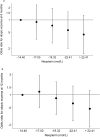Maternal Dietary Inflammatory Status and Serum Neopterin During Pregnancy: Influence on Infantile Atopic Eczema in the Offspring
- PMID: 40714954
- PMCID: PMC12410369
- DOI: 10.1002/clt2.70080
Maternal Dietary Inflammatory Status and Serum Neopterin During Pregnancy: Influence on Infantile Atopic Eczema in the Offspring
Abstract
Background: A protective influence of maternal inflammatory status on infantile atopic eczema risk has been proposed, but few studies have investigated these potential links. We examined the associations between energy-adjusted dietary inflammatory index (E-DII) scores indicative of an inflammatory dietary pattern, maternal serum neopterin levels, a biomarker elevated in Th1 immune activation, and infantile risk of atopic eczema.
Methods: Within the UK Southampton Women's Survey, mothers' diets were recorded using questionnaires at preconception, early and late pregnancy and E-DII scores derived. 3006 deliveries of live born infants with no major congenital growth abnormalities who were assessed for atopic eczema at 6 or 12 months (ascertained using the UK Working Party Diagnostic Criteria [n = 2955 and 2871, respectively]). A sub-sample of 497 mothers had serum neopterin measured in late pregnancy.
Results: Unadjusted analyses showed that higher E-DII in preconception and late pregnancy was associated with a lower risk of eczema at ages 6 and 12 months. After adjusting for maternal BMI, age, parity, education, smoking during pregnancy, breastfeeding duration and sex, higher E-DII in late pregnancy was associated with reduced risks of eczema at age 6 and 12 months (OR 0.89 [95% CI 0.81, 0.99], p = 0.03 and OR 0.91 [0.82, 1.00], p = 0.05, respectively). Consistent with this, higher maternal serum neopterin was associated with a lower risk of eczema at ages 6 months (OR 0.72 [0.51, 1.01], p = 0.05) and 12 months (OR 0.71 [0.53, 0.96], p = 0.03).
Conclusion: The findings suggest that a pro-inflammatory maternal diet and an inflammatory maternal environment during pregnancy may protect the developing infant from Th2 driven inflammation and lower the risk of infantile atopic eczema.
Trial registration: NCT04715945.
Keywords: infantile atopic eczema; maternal diet; neopterin; proinflammatory diet.
© 2025 The Author(s). Clinical and Translational Allergy published by John Wiley & Sons Ltd on behalf of European Academy of Allergy and Clinical Immunology.
Conflict of interest statement
K.M.G. has received reimbursement for speaking at conferences sponsored by companies selling nutritional products. K.M.G. is part of an academic consortium that has received research funding from Bayer, Nestec, BenevolentAI Bio Ltd and Danone, outside the submitted work. N.C.H. reports personal fees, consultancy, lecture fees and honoraria from Alliance for Better Bone Health, AMGEN, MSD, Eli Lilly, Servier, Shire, Radius Health, UCB, Consilient Healthcare and Internis Pharma, outside the submitted work. The other authors have no competing interests.
Figures

References
Associated data
Grants and funding
- UK Medical Research Council; MC_UU_12011/4
- NIHR Senior Investigator (NF-SI-0515-10042)/National Institute for Health Research
- IS-BRC-1215-20004/NIHR Southampton Biomedical Research Centre
- Erasmus++ Programme ImpENSA 598488-EPP-1-2018-1-DE-EPPKA2-CBHE-JP/European Union
- FP7/2007-2013/European Union's Seventh Framework Programme
- 289346/EarlyNutrition and ODIN
- 613977/EarlyNutrition and ODIN
- HDHL-Biomarkers/BBSRC
- BB/P028179/1/BBSRC
- 696295/Horizon
- NIHR Oxford Biomedical Research Centre
- University Hospital Southampton NHS Foundation Trust
- University of Southampton
- National Institute for Health Research Southampton Biomedical Research Centre
- Bupa Foundation
- 4050502589; MC_PC_21003; MC_PC_21001/MRC_/Medical Research Council/United Kingdom
- 17702/ARC_/Arthritis Research UK/United Kingdom
LinkOut - more resources
Full Text Sources
Medical

